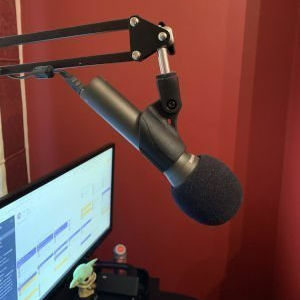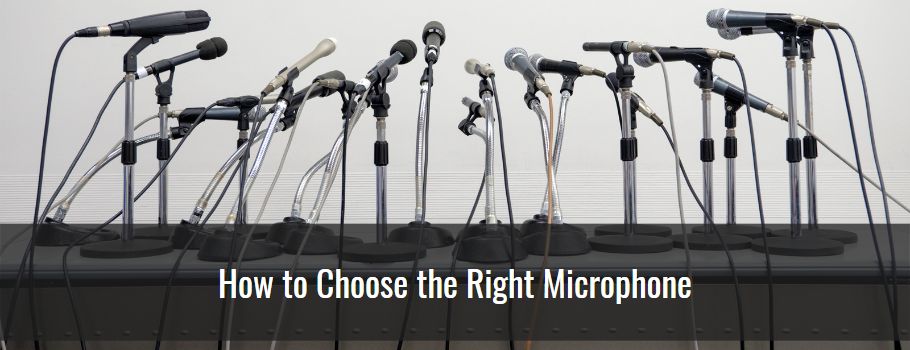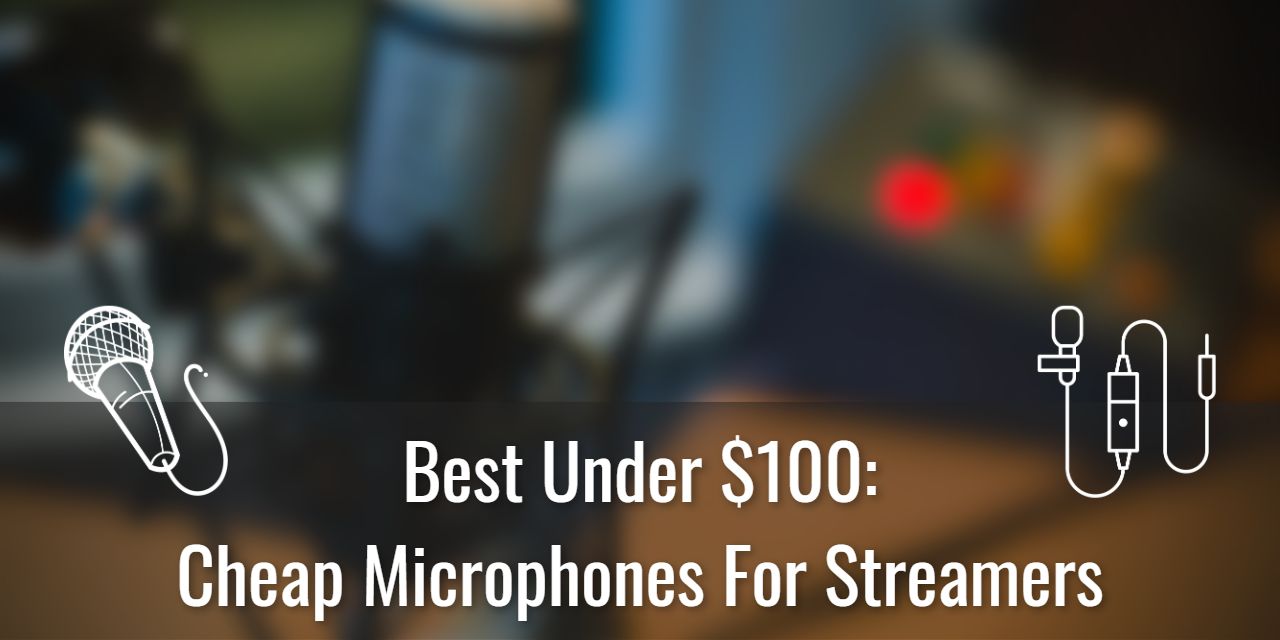So you want to Get into streaming, but you’re on a strict budget? No problem, I know of a few of the best cheap microphones for streamers that do the job.
To make things easier, I’ll explain how to choose the right microphone for you. This matters because some microphones are better for certain kinds of content than others, and choosing the wrong type can result in a poor content creation experience, not to mention poor recordings.
Table of Contents
In a Rush? Here are the Best Cheap Microphones I Recommend

Editor’s Choice – Samson Q2U
Easily the Best All-Rounder Microphone on this list.
How to Choose the Right Microphone

Choosing the right microphone is just as important as its cost. I’ve compiled some information about the different types to make things easier. Note that the price range in each section lists out the lowest price that you can get a microphone and the maximum price I’d recommend spending on one for streaming.
The reason for the price maximum is diminishing returns. The quality does not scale linearly with the cost, as demonstrated by this video by Booth Junkie on YouTube. As that video shows, the $50 mic is very similar to the $1000 mic demonstrated in audio quality. The differences are only noticeable if you have high-quality headphones, like these Beyerdynamic DT 770 Pros I reviewed. I have made a overview of the best microphones for streamers earlier in 2023, if you want to get a selection.
Of course, this comparison is only valid when you have ideal recording conditions, so keep that in mind as you read through this article.
Headsets, the Best Value Up-Front – Two Devices in One
| Cost Range | Audio Quality | Notable Features |
|---|---|---|
| $10 – $150 | Fair | Headphones included |
What makes headsets such a great value, especially if you don’t currently have a microphone or headphones yet, is that they are both a microphone and a pair of headphones. Both of which are beneficial for the purpose of creating live-streaming content. After all, if you’re using speakers as your means of listening to the audio, then there is significant potential for problems to crop up, like music echo, game sounds being duplicated, and more.
As a ton of cheap headsets are marketed toward gamers, that is one of the first avenues to go down. Gaming headsets are basically the definition of cheap, good-looking, and functional audio equipment. All good things for streamers, where the presentation of yourself as an influencer matter. This is because the gaming industry heavily targets a younger demographic, where looks matter far more than function.
Of course, as this article focuses on the cheap microphones for streamers aspect, don’t expect miracles in the sound department. It’s good enough to get the job done, and the audio is very clear, but you will definitely not get an amazing listening experience or great-sounding microphones with cheap gaming headsets. If you want better quality sound for listening to music, I recommend checking out the Beyerdynamic DT 770 Pros, the headphones I use. They don’t have a microphone built-in, though, so you’ll want to keep that in mind too.
The Cheapest Microphone Option – Lavalieres
| Cost Range | Audio Quality | Notable Features |
|---|---|---|
| $1 – $35 | Fair | Clips onto clothing, easily hidden |
If you are super tight on money, you will want a lavalier microphone. A lavalier, or lapel, microphone as it’s sometimes called, is simply a clip-on microphone. One important thing to note for this is that you will likely need one with a long cable to be useful.
There are wireless solutions, but those are not cheap and thus are beyond the scope of this article. If you’re curious about the wireless solution, check out this other article I wrote that discusses more expensive microphone options. There is a wireless lapel option in there that you can take a look at.
The Best Audio Quality Option – Cheap Studio Condenser/Dynamic Microphones
| Cost Range | Audio Quality | Notable Features |
|---|---|---|
| $35 – $400 | Superb | Wide frequency sensitivity |
This section is a little bit more involved due to the complexity of the microphones this covers. It is all good information to know, though.
Condenser and dynamic microphones are easily the best-sounding microphones out there. They are so good that even my cheap $30 Tonor BM-700 microphone is hugely superior to even $180 headsets, like the Logitech G933 I used to use.
How much better? Well, considering that everyone on discord that I have compared the mics with unanimously agrees that it is far better sounding, I think that sort of speaks for itself. Some of my friends even yell at me when I jokingly swap mics out to the headset microphone to mess with them.
The Caveat – Studio Microphones Have Special Needs
But here is where things get complicated. Even though the audio quality is superior, the user-friendliness is far, far worse than consumer-grade hardware.
With a headset microphone, or lapel, all you need to do is plug it in, and it just works. Unless there is some sort of damage to the microphone wire, it will be detected and work on any device that sports a 3.5mm cable or USB device.
Many Studio microphones have a completely different connector type, which is known as XLR. If you accidentally buy this microphone format, then you’ll be disappointed to learn it isn’t as plug-and-play as the 3.5mm options. Of course, this is a problem the industry recognized a long time ago, and USB-format studio microphones were created to answer this concern.
Now, we are left with a confusing mess of marketing.
Say you searched “Best cheap microphones for streamers,” which you probably did if you are here. Many articles that target this query do not adequately bring the XLR issue to your attention when including them in the list or omit them entirely to make their list as user-accessible as possible.
I see this as a missed opportunity to educate you guys on these facets of microphone technology.
XLR Format Microphones
What makes an XLR microphone so user-unfriendly is that it requires either a phantom power kit, an audio interface, or an audio mixer to work as a streaming mic. The fact that it requires extra equipment makes this a less viable option if your goal is to keep the cost down. With that said, XLR microphones tend to be much cheaper than their USB counterparts, for reasons I explain in the next section that addresses USB microphones.
For an idea of what kind of extra cost comes into play, I have a Behringer UMC204HD, which cost me almost four times what the BM-700 did. And that microphone was also bundled with a pop filter, microphone boom arm, shock mount, a short and basic XLR cable, a phantom power box, AND an xlr to 3.5mm cable for under $60.
Audio equipment gets very expensive very quickly.
USB Format Microphones
The other format of microphones is USB power. This is made possible thanks to an internal audio interface within the microphone body that contains the ADC (Analog to Digital Converter) and the voltage stepper to interface with a computer. This internal interface is why USB microphones tend to be more expensive than their XLR counterparts.
The downside with this design approach is that the audio interface that is built in is stripped down compared to XLR variants. Additionally, a USB microphone requires a computer in order to use. This is fine for use as a live streaming mic, as you need a computer to broadcast, to begin with, but it does limit the number of devices that you can use with the microphone.
For example, though it isn’t recommended, you can convert an XLR microphone using the phantom power kit into a 3.5mm jack to be able to use XLR microphones with your phone using one of these cables. This vastly expands the number of compatible devices beyond a smartphone, making the XLR approach a far more device-compatible option.
For user ease of use, though, USB is a solid win.
The Best If You Need Headphones and a Low Price – Razer Kraken
You don’t have to be a gamer to recognize the green snake logo of Razer. The gaming peripheral company has been a huge player in the industry, aiming to be the top dog of gaming gear. They have seated themselves in this position with a few revolutionary designs that aimed to improve the player experience. For example, Razer was the first company to release an MMO-focused gaming mouse in 2009 with the Razer Naga.
That mouse incidentally changed my life, as it also gave mice a more accessible design (a perfect example of pushing the standards forward). As a result, I am slightly biased in recommending their products over others, where the products are closely in line with each other.
That leads me to the Razer Kraken Headset. This wired headset is one of the most recommended headsets for gamers on a tight budget. The reason is simple, it answers a subset of the market:
- Offering multiple color options
- Good enough audio clarity and quality
- Easy to use
- Cheap
I don’t have my old pair of Krakens anymore for pictures, but I used them before I got the wireless bug and picked up the Logitech G933s. It sounded worse than the G933’s, but it can’t be beaten for the price.
Pros:
- Cheap
- Headphones & Microphone combo
- Comes in a variety of colors
- Decent audio quality
- The cable is decently long
Cons:
- The build quality feels a bit plasticky
- Susceptible to radio interference
- I’d recommend getting a Ferrite core or a ground loop isolator if you hear a hiss in your audio signal.
- The microphone stem can break easily if you kink the wire too much.
The Cheapest Option, by Far – Amazon Basics Lapel
Now, a bit of a disclaimer here, I have never used the Amazon Basics lapel microphone myself. However, choosing it seemed like a no-brainer, as the cost was ludicrously low. Audio quality aside, which I cannot personally attest to, when we are talking about listing off cheap microphones for streamers, including the cheapest microphone I could find seemed like something I should do.
Due to my lack of personal experience using this microphone, I can only give you a basic overview of the microphone and note any shortcomings in its specifications. I can say with certainty that it will likely suffer from radio interference due to the tendency for microphones to act like a very bad antenna, picking up electromagnetic interference in the form of hiss.
This problem can be dealt with using the things I’ve mentioned in the cons list below or by using other background noise removal solutions.
Pros:
- Extremely cheap
- Easily hidden behind clothes
- Omni-directional pickup pattern
- The audio quality is okay for the price, according to reviews
Cons:
- Only five feet of cable length
- Consider getting a 3.5mm Extension cable
- Susceptible to radio interference
- I’d recommend getting a Ferrite core or a ground loop isolator if you hear a hiss in your audio signal.
- May need to secure it very tightly to prevent rubbing noise when clothing rubs against the microphone
The Highest Quality Audio Option – Maono Condenser
Side Address Microphone – Talk into the Side with the Logo for the Best Results
When quality on a budget is your concern, then you will need to consider getting a studio condenser or dynamic microphone. In the case of my recommendation, that means the Maono Condenser. This off-brand microphone is a cheap USB condenser that comes with a basic kit:
- A Pop Filter
- A Microphone Boom Arm
- A Shock mount for the microphone
- A Foam windscreen
- Two velcro wire ties
- And the USB cable itself
All for under $50. For a first microphone, this is a great investment for the purpose of streaming and is why it made the best cheap microphones for streaming.
It’s basically the same thing as my Tonor BM-700 kit, just USB instead of XLR.
Pros:
- Highest potential audio quality in this list under the right conditions (acoustically treated room)
- Plug & Play USB
- Comes with a pop filter
- Far less wires to manage than an XLR setup
- Immune to radio interference due to how it works
Cons:
- Extremely sensitive – it will pick up your keyboard clacks and your mouse clicks, especially if you’re a mechanical keyboard user.
- Consider using NVIDIA broadcast to deal with this unwanted noise if you happen to have an RTX graphics card like the one I have. (Formerly Known as RTX Voice). See it in action!
- Takes up a lot of desk real-estate
- This kit utilizes a microphone boom arm and shock mount.
- The included boom arm is extremely flimsy; expect it to last about a year tops. Here is my recommended replacement when it does eventually bite the dust. It’s what I’ve been using since May 18, 2020. (still in great condition)
- Included boom arm may damage the finish on wooden desks.
- Do NOT attempt to mount microphone boom arms to glass-top desks. Too much pressure and the desk glass top can shatter. (Don’t ask how I know this…)
- If you have to mount to the glass directly, put in two thin pieces of plywood between the top and bottom to apply pressure across a larger surface area, reducing (but not eliminating) the chance of breakage.
- Can block the view of your monitor if your desk is small
- Not compatible with all devices
The Best Cheap Microphones Overall Winner – Samson Q2U

Front Address Microphone – Talk Into the Top for the Best Results
The last microphone on my list for the best cheap microphones for streamers, but certainly not the least, is the Samson Q2U. This Dynamic microphone is just a bit more money than the Maono USB Condenser microphone but has some really useful features that make it a better choice for streamers.
Mainly, I’m referring to the fact that the Q2U is both an XLR and a USB microphone in one chassis. This means that you can use either USB or XLR as your output. You can also monitor it in real time through the 3.5mm jack in the bottom of the microphone.
With that said, this microphone has some downsides, the most glaring being that the design utilizes what is now considered ancient technology, a mini-USB connector. When was the last time you bought one of those cables? Nevertheless, the connection type is nothing more than a user convenience than a limitation. The microphone still performs admirably in the quality department
Now, if the fact that the microphone uses such an old design is a turn-off for you, there are other similar hybrid microphones with more modern USB connectors. Of course, they are more expensive, but that’s to be expected.
Pros:
- Fantastic Audio Quality when used properly
- Ability to hold the microphone in your hand if you need to
- Hybrid XLR/USB design
- Easy Plug & Play
- Compatible with external Audio Interfaces and devices they support
- Comes with a windscreen to protect against fast-moving air that causes distortion
Cons:
- The most expensive microphone on this list
- Uses Mini-USB, a seriously outdated connector
- You need to be 1-5 inches away from the microphone and talking directly into the diaphragm to be heard with good-quality audio.
- Basic design doesn’t draw a lot of attention.
- Not a Shure SM7B (This is one of the most popular microphones that podcasters and streamers use. It is exceedingly expensive and thus not on this list.)




